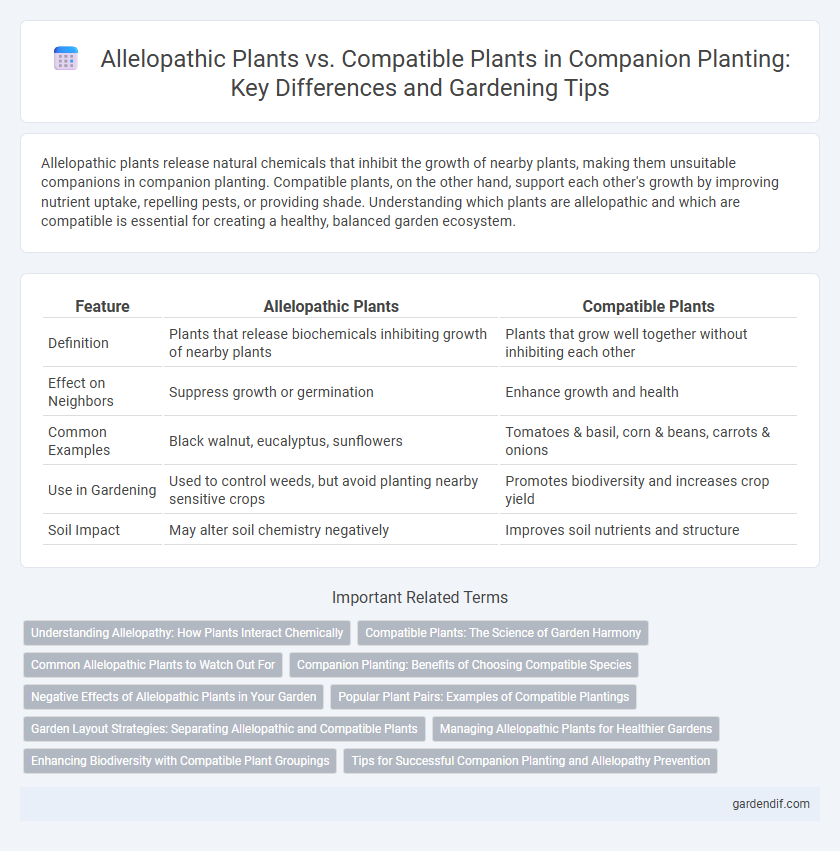
Allelopathic plants vs compatible plants Illustration
Allelopathic plants release natural chemicals that inhibit the growth of nearby plants, making them unsuitable companions in companion planting. Compatible plants, on the other hand, support each other's growth by improving nutrient uptake, repelling pests, or providing shade. Understanding which plants are allelopathic and which are compatible is essential for creating a healthy, balanced garden ecosystem.
Table of Comparison
| Feature | Allelopathic Plants | Compatible Plants |
|---|---|---|
| Definition | Plants that release biochemicals inhibiting growth of nearby plants | Plants that grow well together without inhibiting each other |
| Effect on Neighbors | Suppress growth or germination | Enhance growth and health |
| Common Examples | Black walnut, eucalyptus, sunflowers | Tomatoes & basil, corn & beans, carrots & onions |
| Use in Gardening | Used to control weeds, but avoid planting nearby sensitive crops | Promotes biodiversity and increases crop yield |
| Soil Impact | May alter soil chemistry negatively | Improves soil nutrients and structure |
Understanding Allelopathy: How Plants Interact Chemically
Allelopathic plants release biochemicals into the soil that inhibit the growth of neighboring plants, influencing plant interactions through chemical means. These secondary metabolites act as natural herbicides, affecting seed germination, root development, and nutrient uptake in surrounding plants. Understanding these chemical interactions helps gardeners select compatible companion plants that coexist harmoniously, enhancing growth and biodiversity.
Compatible Plants: The Science of Garden Harmony
Compatible plants promote garden harmony by enhancing growth through beneficial interactions such as nutrient sharing, pest deterrence, and improved soil health. For example, legumes like peas and beans enrich soil nitrogen, supporting nearby plants like corn or cucumbers without competition. Understanding plant compatibility maximizes yield and biodiversity by fostering balanced ecosystems while minimizing the negative effects of allelopathic plants that release growth-inhibiting chemicals.
Common Allelopathic Plants to Watch Out For
Common allelopathic plants to watch out for include black walnut (Juglans nigra), which releases juglone that inhibits growth of sensitive plants like tomatoes and apples. Eucalyptus trees emit allelochemicals affecting undergrowth and neighboring crops, reducing germination and growth rates. Sunflowers (Helianthus annuus) produce allelopathic compounds in their roots and leaves that can suppress weeds but may also harm nearby plants such as beans and lettuce.
Companion Planting: Benefits of Choosing Compatible Species
Companion planting enhances garden productivity by pairing compatible plants that support each other's growth, such as nitrogen-fixing legumes with nutrient-demanding vegetables. Allelopathic plants release biochemicals that inhibit the growth of certain neighbors, making their placement critical to avoid stunted development in susceptible species. Selecting compatible species maximizes natural pest control, improves soil health, and promotes balanced nutrient uptake, leading to sustainable and efficient garden ecosystems.
Negative Effects of Allelopathic Plants in Your Garden
Allelopathic plants release biochemicals that inhibit the growth of nearby compatible plants, leading to reduced germination rates and stunted development. These natural toxins can disrupt nutrient uptake and soil microbial balance, ultimately decreasing overall garden productivity and biodiversity. Managing allelopathic species is essential to maintain a healthy companion planting scheme and prevent adverse interactions.
Popular Plant Pairs: Examples of Compatible Plantings
Tomatoes and basil form a popular compatible plant pair, with basil enhancing tomato flavor and repelling pests. Marigolds planted alongside beans deter harmful nematodes while attracting beneficial insects for pollination. Carrots interplanted with onions benefit from the onion's allelopathic properties that reduce carrot root fly infestations, illustrating effective companion planting strategies.
Garden Layout Strategies: Separating Allelopathic and Compatible Plants
Separating allelopathic plants from compatible plants in garden layout strategies enhances overall plant health and yield by minimizing chemical interference. Designating distinct zones for allelopathic species like black walnut or sunflower prevents root-secreted toxins from inhibiting neighboring plant growth. Incorporating buffer plants or barriers further supports optimized companion planting, ensuring mutual benefits and reduced allelopathic stress.
Managing Allelopathic Plants for Healthier Gardens
Managing allelopathic plants involves identifying species such as black walnut and eucalyptus, which release chemicals inhibiting the growth of nearby plants. Integrating compatible plants like marigolds or legumes can improve soil health and reduce negative allelopathic effects. Strategic garden planning enhances biodiversity while promoting healthier, more resilient plant communities.
Enhancing Biodiversity with Compatible Plant Groupings
Allelopathic plants release biochemicals that inhibit the growth of nearby species, reducing biodiversity and limiting companion planting options. Compatible plants, chosen for their mutual benefits such as pest resistance and nutrient sharing, create diverse ecosystems that support pollinators and improve soil health. Enhancing biodiversity through strategic compatible plant groupings promotes resilient gardens and sustainable agricultural practices.
Tips for Successful Companion Planting and Allelopathy Prevention
Choose compatible plants that do not release allelopathic chemicals to ensure healthy growth and maximize yields in companion planting. Incorporate organic mulch and maintain proper spacing to reduce the impact of allelopathic root exudates and improve soil aeration. Regularly monitor plant health and rotate crops to prevent the buildup of allelochemicals and promote sustainable garden ecosystems.
Allelopathic plants vs compatible plants Infographic

 gardendif.com
gardendif.com